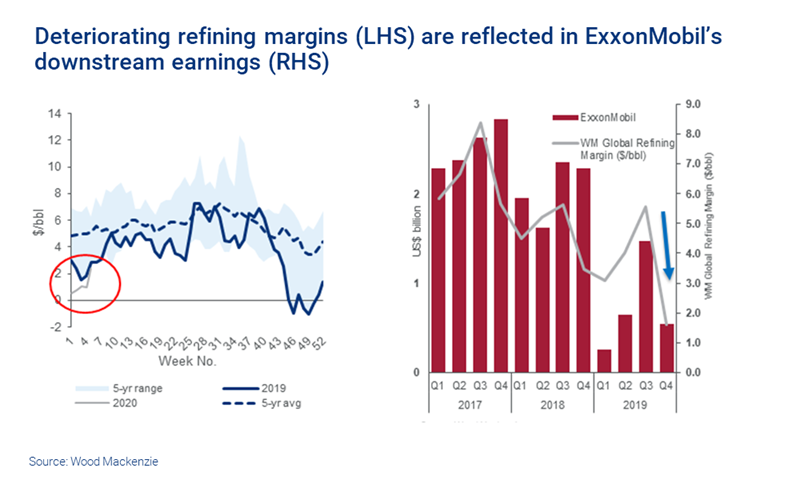Refining set for a challenging 2020
IMO and weak demand put margins under pressure
1 minute read
Simon Flowers
Chairman, Chief Analyst and author of The Edge

Simon Flowers
Chairman, Chief Analyst and author of The Edge
Simon is our Chief Analyst; he provides thought leadership on the trends and innovations shaping the energy industry.
Latest articles by Simon
-
The Edge
Upstream’s mounting challenge to deliver future oil supply
-
The Edge
A world first: shipping carbon exports for storage
-
The Edge
WoodMac’s Gas, LNG and the Future of Energy conference: five key themes
-
The Edge
Nigeria’s bold strategy to double oil production
-
The Edge
US tariffs – unpredictability is the strategic planners’ nightmare
-
The Edge
US upstream gas sector poised to gain from higher Henry Hub prices
Downstream isn’t the glamorous end of the oil business. And in Big Oil, it’s typically dwarfed by upstream. Yet having been forced to restructure and focus on costs early this century, downstream’s cash flow has underpinned a third of the Majors’ shareholder returns over the last five years.
But a laser-like focus on costs and efficiency can only take you so far. If the external environment turns against you, downstream is as vulnerable as any part of the business. The Majors’ downstream results for Q4 2019 were among the poorest since 2015. Petrochemicals is part of that story, with earnings suffering from over-investment.
Now we’re also seeing refining margins come under increasing pressure, slipping to five-year lows in the last few weeks of 2019 and the first of 2020. Alan Gelder, VP Refining, identifies two main factors.
Firstly, new regulation on marine fuels was expected to boost refining margins this year – but that hasn’t played out as expected yet. The International Maritime Organization (IMO) regulations require all vessels to reduce the level of sulphur in their engine emissions from 3.5% to 0.5% or less from 1 January.
New regulation on marine fuels was expected to boost refining margins this year – but that hasn’t played out as expected yet.

Alan Gelder
SVP Refining, Chemicals & Oil Markets
Alan is responsible for formulating our research outlook and cross-sector perspectives on the global downstream sector.
Latest articles by Alan
-
The Edge
Upstream’s mounting challenge to deliver future oil supply
-
Opinion
The impact of the Israel-Iran conflict escalation on the global energy market
-
Opinion
Oil and refining market implications of Israel’s strike on Iran
-
Opinion
What is the impact of US tariffs on oil and refining?
-
Opinion
Oil and refined products in 2025: a commodity trader’s guide
-
Opinion
Global refinery closure outlook to 2035
Essentially, IMO should trigger a shift out of low-value product (High Sulphur Fuel Oil, or HSFO) into higher value Very Low Sulphur Fuel Oil (VLSFO). Refinery capacity to make VLSFO is limited, so marine gasoil, which is closely linked to the price of diesel, would top up any shortfall. This shift to high-value products was expected to drive up refining margins in 2020.
It’s only half happened. The price of VLSFO surged in Q4 and HSFO duly collapsed. The surprise was that there’s been much more VLSFO available than expected. Traders had taken advantage of low-price feedstock in late summer 2019 and built up volumes of VLSFO in storage. When the demand came in, they were ready and cashed in, big time. A single tanker loaded with 2 million barrels of VLSFO could make over US$10/bbl on the spread and pull in US$20 million-plus in cash profit.
Producers with the right crude have also fared well. Santos revealed that it had sold a single cargo of heavy sweet crude, ideal feedstock for VLSFO, at an unheard-of US$30/bbl premium to Brent. Nice work if you can get it.
What didn’t really materialise was higher demand for marine gasoil – it’s just not been needed in the volumes anticipated. Weaker marine demand for gasoil has been compounded by soft demand from heating – a much bigger market – because of warm winter weather in the northern hemisphere and lacklustre economic growth. That’s led to a glut of gasoil in inventory which is depressing refining margins.
Second, global oil demand growth forecasts are falling back sharply – potentially a more fundamental problem. The biggest factor is the coronavirus, so we have reduced our demand forecasts in China by almost 0.6 million b/d for Q1 2020. We now expect China demand to fall year-on-year by 125,000 b/d for the quarter, the worst rate since 2009. Global demand will fall by 250,000 b/d, also the worst in over a decade.
So what’s next for refining?
The VLSFO surplus should be a short-term phenomenon. There’s not enough refining capacity to supply all bunker demand with VLSFO. That gap will have to be met by additional gasoil once the surplus VLSFO in inventory is soaked up, by H2 2020 at the latest.
The prospects for oil demand are more worrying and harder to call. At this stage, we have restricted our adjustments to Q1 and left the rest of the year largely unchanged. If the virus can be contained successfully in the coming weeks, demand could bounce back strongly – much as was the case with SARS in 2003.
Refining margins so far in Q1 suggest it will take a while before refining profitability recovers. Meantime, refiners will do what they must to keep costs down and maximise cash flows, including cutting refinery runs to limit the build-up in inventory. It’s about toughing it out, waiting and hoping for demand – China in particular – to perk up again.









